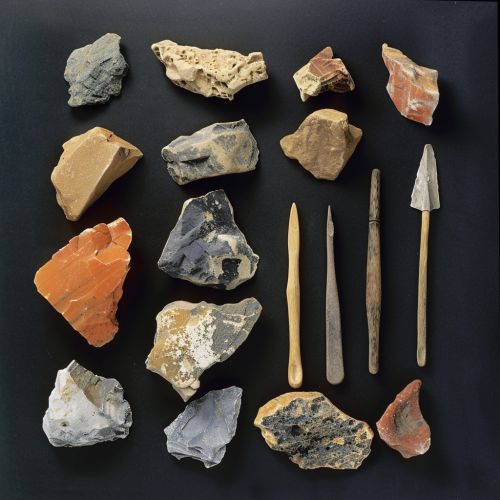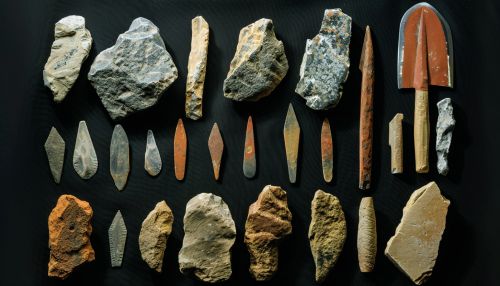Mousterian: Difference between revisions
(Created page with "== Mousterian == The Mousterian is a significant archaeological culture of the Middle Paleolithic period, predominantly associated with Neanderthals and early modern humans. This culture is named after the type site of Le Moustier, a rock shelter in the Dordogne region of France. The Mousterian culture is characterized by its distinctive stone tool technology, which marks a significant advancement in prehistoric tool-making techniques. <div class='only_on_desktop image...") |
No edit summary |
||
| Line 3: | Line 3: | ||
The Mousterian is a significant archaeological culture of the Middle Paleolithic period, predominantly associated with Neanderthals and early modern humans. This culture is named after the type site of Le Moustier, a rock shelter in the Dordogne region of France. The Mousterian culture is characterized by its distinctive stone tool technology, which marks a significant advancement in prehistoric tool-making techniques. | The Mousterian is a significant archaeological culture of the Middle Paleolithic period, predominantly associated with Neanderthals and early modern humans. This culture is named after the type site of Le Moustier, a rock shelter in the Dordogne region of France. The Mousterian culture is characterized by its distinctive stone tool technology, which marks a significant advancement in prehistoric tool-making techniques. | ||
[[Image:Detail-91265.jpg|thumb|center|A collection of Mousterian stone tools, including scrapers, points, and hand axes.|class=only_on_mobile]] | |||
[[Image:Detail-91266.jpg|thumb|center|A collection of Mousterian stone tools, including scrapers, points, and hand axes.|class=only_on_desktop]] | |||
=== Historical Context === | === Historical Context === | ||
Latest revision as of 02:01, 22 June 2024
Mousterian
The Mousterian is a significant archaeological culture of the Middle Paleolithic period, predominantly associated with Neanderthals and early modern humans. This culture is named after the type site of Le Moustier, a rock shelter in the Dordogne region of France. The Mousterian culture is characterized by its distinctive stone tool technology, which marks a significant advancement in prehistoric tool-making techniques.


Historical Context
The Mousterian culture emerged approximately 160,000 years ago and persisted until around 40,000 years ago. It is primarily found in Europe and the Near East, with notable sites including La Ferrassie, Combe Grenal, and Kebara Cave. The culture is named after the Le Moustier site, where the first significant assemblage of Mousterian tools was discovered.
The Mousterian period coincides with the latter part of the Middle Paleolithic, a time characterized by the presence of Neanderthals in Europe and the Near East. This period also overlaps with the early presence of anatomically modern humans in these regions, leading to significant interactions between these two hominin groups.
Stone Tool Technology
The hallmark of the Mousterian culture is its sophisticated stone tool technology. Mousterian tools are primarily made using the Levallois technique, a method of flake production that involves the preparation of a stone core to produce uniformly shaped flakes. This technique represents a significant advancement over earlier, more rudimentary methods of tool production.
Mousterian tools include a variety of scrapers, points, and hand axes. Scrapers were used for working hides and wood, while points were likely used as spear tips for hunting. Hand axes, although less common in Mousterian assemblages compared to earlier periods, were still an important part of the tool kit.
Subsistence and Lifestyle
The Mousterian culture is associated with a hunter-gatherer lifestyle. Neanderthals and early modern humans of this period relied heavily on hunting large game, such as mammoths, bison, and reindeer. Evidence from sites like La Ferrassie and Combe Grenal indicates that these hominins also exploited smaller animals and plant resources.
Mousterian sites often show evidence of seasonal occupation, suggesting that these groups moved between different locations throughout the year to exploit various resources. The presence of hearths and other features indicates that they had a complex understanding of fire and its uses.
Symbolic Behavior and Cognitive Abilities
One of the most intriguing aspects of the Mousterian culture is the evidence for symbolic behavior and advanced cognitive abilities. Neanderthals and early modern humans of this period engaged in activities that suggest a level of abstract thinking and cultural expression.
For example, the use of pigments and the presence of personal ornaments at some Mousterian sites indicate that these hominins engaged in body decoration and possibly symbolic communication. Additionally, the burial of the dead, as seen at sites like Kebara Cave and La Chapelle-aux-Saints, suggests that they had complex beliefs about life and death.
Regional Variations
The Mousterian culture is not uniform across its geographic range. There are significant regional variations in tool types and assemblage compositions, reflecting adaptations to different environments and resources. For example, the Mousterian of the Levant, often referred to as the Levantine Mousterian, shows distinct differences from the Mousterian of Western Europe.
These regional variations are important for understanding the adaptive strategies of Neanderthals and early modern humans. They also provide insights into the interactions between different hominin groups and the spread of technological innovations.
Decline and Transition
The decline of the Mousterian culture is closely tied to the disappearance of Neanderthals and the rise of the Aurignacian culture, which is associated with anatomically modern humans. This transition occurred around 40,000 years ago and marks a significant shift in the archaeological record.
The reasons for the decline of the Mousterian culture and the extinction of Neanderthals are still debated among researchers. Factors such as climate change, competition with modern humans, and changes in subsistence strategies likely played a role.
